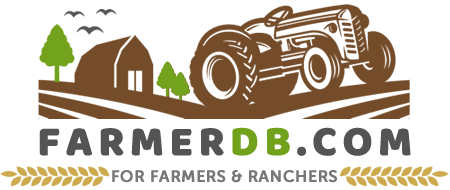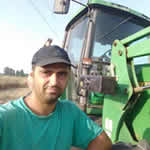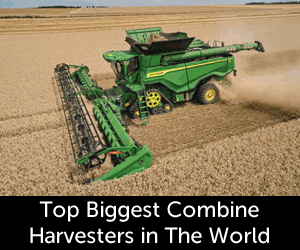Simmental cattle are a dual-purpose breed originally from Switzerland, known for their use in both milk and meat production.
They are one of the oldest and most widely distributed cattle breeds in the world.
What makes Simmental cattle unique is their large variation within the breed, which is greater than that of any other cattle breed.
Over time, they have been bred in different parts of the world to develop specific traits, leading to the creation of various types.
This diversity reflects their adaptability and versatility in meeting the needs of farmers across the globe.
This article focuses on the original Simmental cattle.
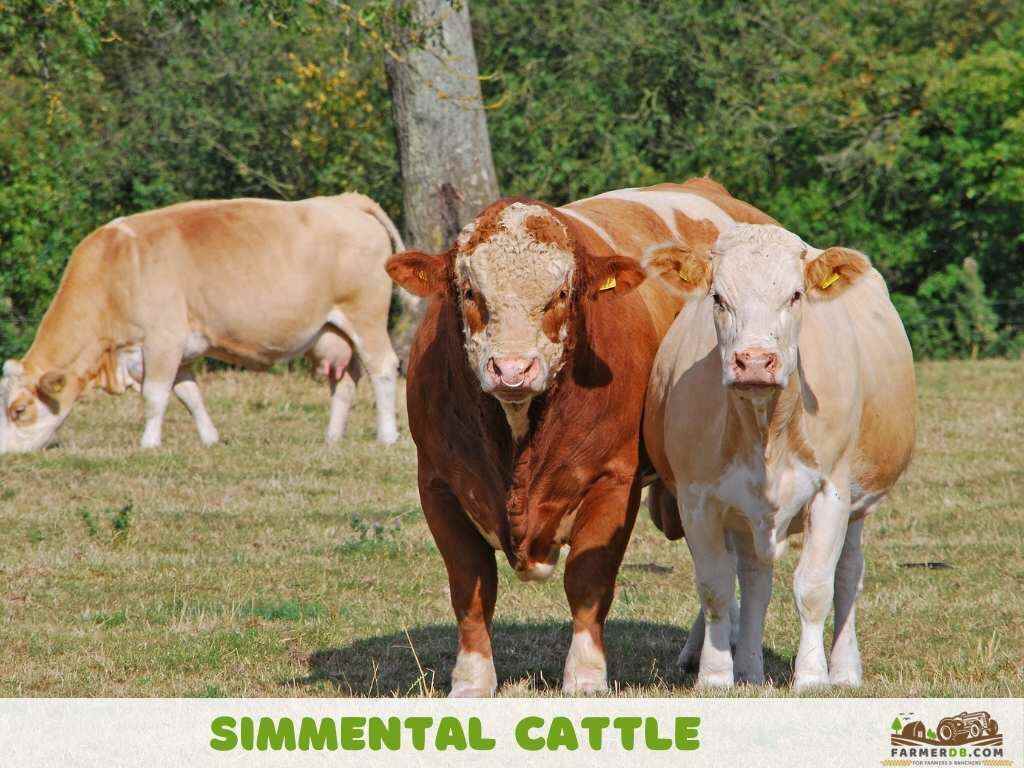
Contents
Types of Simmental Cattle
Not all Simmental cattle are the same. They differ in purpose, appearance, and regional adaptations.
Simmental cattle have expanded far beyond their Swiss origins, spreading across Europe, Asia, Africa, and the Americas.
Their adaptability and versatility have made them popular in countries like Germany, Austria, France, Russia, the United States, and South Africa. In Russia alone, multiple regional types have been developed to suit diverse climates and production needs.
Similarly, France has bred Simmental cattle with a focus on dairy production, while in Germany and Austria are recognized as Fleckvieh, combining both milk and meat production.
Differences Between the Types
Original Swiss Simmental
- Origin: Switzerland
- Characteristics: Dual-purpose breed used for both milk and meat production. These cattle are robust, have a red-and-white or golden-yellow-and-white coat, and are known for their adaptability.
Fleckvieh (German-Austrian Simmental)
- Origin: Germany and Austria
- Characteristics: Primarily a dual-purpose breed but increasingly focused on dairy production. They are larger and heavier compared to the original Simmental.
American Simmental
- Origin: United States (from imported Swiss Simmental)
- Characteristics: Primarily bred for beef production in the U.S. The American Simmental is larger and often has a solid coat due to crossbreeding with Angus and other beef breeds.
French Simmental (Pie Rouge)
- Origin: France
- Characteristics: Focused more on dairy production. They are slightly smaller than their Swiss counterparts and have better milk production characteristics.
British Simmental
- Origin: United Kingdom
- Characteristics: Bred predominantly for beef. These cattle tend to be more uniform in size and color and are valued for their excellent meat quality.
Italian Simmental (Pezzata Rossa Italiana)
- Origin: Italy
- Characteristics: It is used for both milk and meat production, with a strong emphasis on dairy.
South African Simmental
- Origin: South Africa
- Characteristics: Adapted to tropical climates, they are used for beef production. They retain the traditional red-and-white markings.
Australian Simmental
- Origin: Australia
- Characteristics: Bred primarily for beef. Australian breeders have emphasized hardiness and adaptation to local environmental conditions.
Characteristics
Colors
The colors of Simmental cattle are red-and-white or golden-yellow-and-white.
The red color ranges from light to dark shades, with clearly defined patches or spots. White is often found on the head, lower body, and legs.
Skin
The skin is medium-thick and supple, with a pink and elastic texture.
Head
The head is medium-sized and proportional to the body. Bulls have a shorter and broader head, giving them a more robust appearance, while cows have a finer and more delicate head structure.
Both have a broad forehead and a calm, friendly expression.
Horns
The original cattle are horned.
The horns are light yellow to white in color. They are short to medium in length and curve outward and slightly upward.
Through selective breeding, polled Simmental lines now exist.
Face
The face is white and has clear, symmetrical features. The eyes are large, expressive, and set wide apart.
The nose is broad and oval, while the muzzle is wide with large, strong incisors that align perfectly against the dental pad.
Neck
The neck is medium in length, muscular, and blends smoothly into the shoulders. The skin on the neck is loose but not excessive.
Shoulders
The shoulders are well-developed and muscular. They fit smoothly into the body without protruding excessively.
Body
The body is long and deep, showing the capacity for both milk and meat production. The chest is broad and deep, with a strong girth. The backline is straight and strong, indicating structural integrity. The ribs are well-sprung and open, providing ample space for feed intake and milk production.
Legs, Hooves
The front legs are straight, sturdy, and well-set under the body. The back legs are slightly angled, strong, and well-muscled.
The hooves are hard, uniform, oval, and closed
Udder and Teats
The udder is well-attached, capacious, and symmetrically shaped. It has strong ligaments to support its structure. The teats are medium in size and evenly spaced.
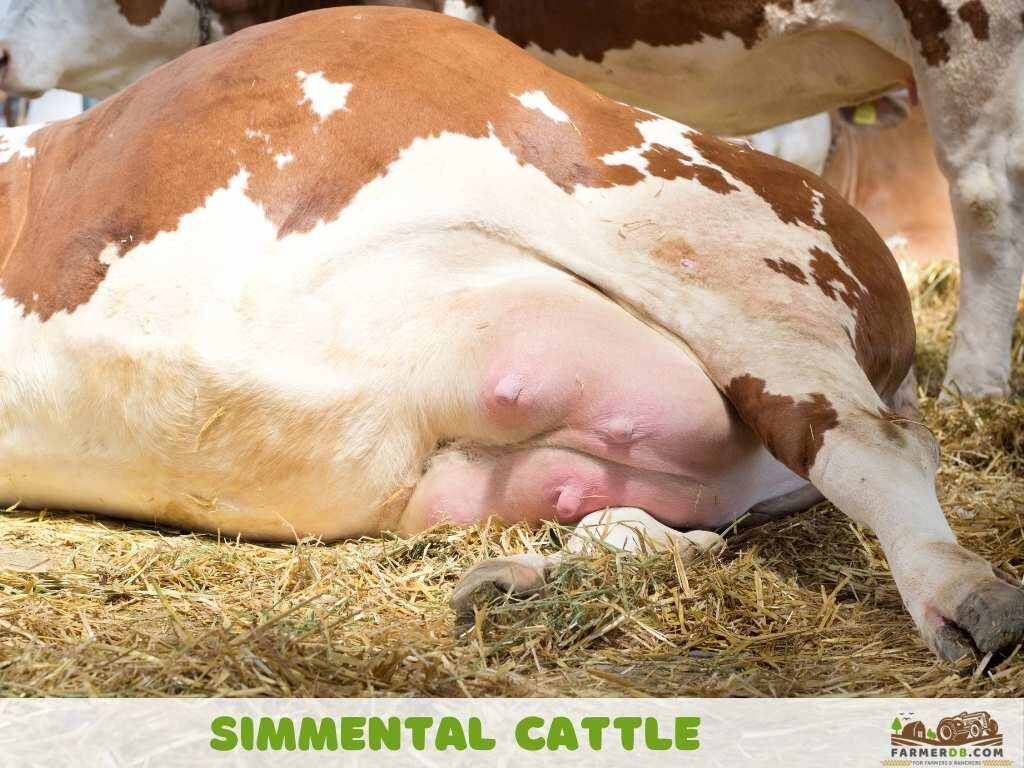
Testicles
The testicles are well-developed, firm, and symmetrical in size, with a short and sturdy seminal cord.
Size
These cattle have a large size.
Their height ranges from 59 to 70 inches (150-178 cm), while their width spans 22 to 25.6 inches (56-65 cm). The length of the cattle extends from 83 to 98 inches (212-250 cm). Additionally, the withers height measures between 53.1 and 63 inches (135-160 cm).
In the Simmental family, they are larger than the French and British Simmental but smaller than the Fleckvieh and American Simmental.
Lifespan
Simmental cattle have a lifespan of 15 to 20 years, though this can vary depending on whether they are raised for milk or meat production.
Cattle used for milk production tend to have a shorter lifespan, around 8 to 10 years, due to the physical demands of high milk yields. In contrast, those bred for meat often live closer to the upper end of the lifespan range.
Growth Rate
How fast do they grow?
These cattle have a fast growth rate.
Under good diet and management conditions, a cattle can gain between 2.6 to 3.3 lbs (1.2 to 1.5 kg) per day. When raised with high-quality feedlots, the average daily gain can even exceed 3.5 lbs (1.6 kg) per day.
In less intensive systems, daily gains might be closer to 2.2 to 2.6 lbs (1.0 to 1.2 kg), depending on pasture quality and overall management.
Even when raised for milk, they grow rapidly during the rearing phase, ensuring they reach breeding or lactating maturity quickly. Once they begin milk production, energy is directed more toward milk output rather than continuous body weight gain. However, they still maintain a good balance between milk yield and moderate growth.
Weight
A mature bull can weigh between 2,315 and 2,865 lbs (1,050 to 1,300 kg), while a mature cow weighs between 1,545 and 1,985 lbs (700 to 900 kg).
At birth, calves usually weigh between 66 and 100 lbs (30 to 45 kg).
Slaughtered Time
These cattle can be slaughtered at around 16 to 24 months of age.
Simmental breed has a larger frame than Angus or Hereford.
The weight at that age can vary depending on the diet they are offered.
Cattle raised in a feedlot system can reach a live weight of 1,320–1,650 lbs (600–750 kg) by this age. In contrast, cattle raised on a grass-fed system achieve a slightly lower weight of around 1,210–1,430 lbs (550–650 kg).
The dressing percentage of this breed is between 58 and 61%.
Example Calculation: A steer weighing 1,430 lbs (650 kg) live weight would yield a carcass of approximately 831 to 874 lbs (377 to 396 kg).
Temperament
These cattle are characterized by a gentle and calm temperament.
In fact, their docility and good behavior are among the reasons they are popular with farmers, whether for small-scale or commercial operations.
Their calm demeanor allows them to handle transportation and handling well, reducing stress for both the animals and the farmers.
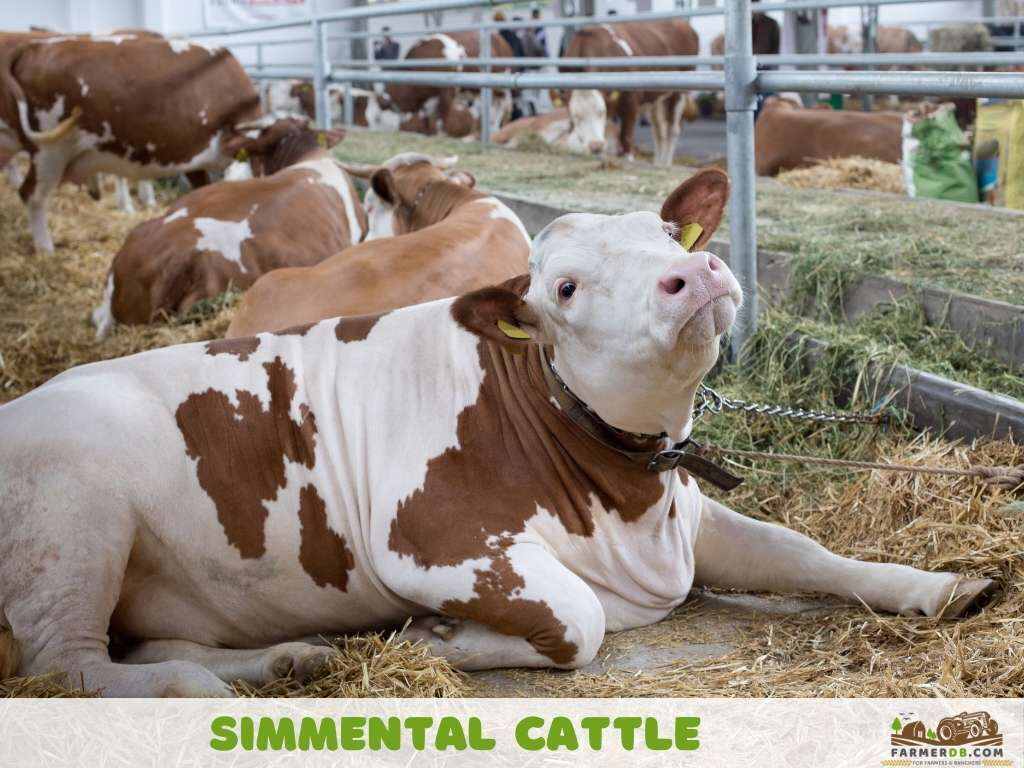
In general, they are cooperative. When accustomed to human interaction from a young age, they do not become fearful or stressed. Like other domestic animals, they benefit from early exposure to a variety of elements in their environment.
Simmental cows are known for their good maternal instincts, which, combined with their calm temperament, make calving and raising offspring easier.
Simmental cattle are also effective grazers, capable of grazing for extended periods without difficulty.
Meat
Simmental beef is considered a high-quality choice. In regions like Switzerland and southern Germany, it enjoys a premium reputation due to natural alpine production methods and exclusive reliance on grass-fed systems.
The meat has a rich, robust flavor that remains clean and savory, reflecting its sustainable, pasture-raised origins. Its texture is smooth and consistent, making it well-suited for steaks, roasts, and slow cooking.
While it doesn’t possess the intense marbling of Wagyu or other highly specialized breeds, this meat offers a satisfying balance of tenderness and flavor. This consistency makes it a favorite among butchers and chefs alike.
The ribeye section from these cattle often features larger, more uniform muscles, while sirloin and strip loin cuts are longer or thicker than average. This makes them particularly suitable for generous portion sizes and premium steak presentations. Additionally, the meat has an attractive, rich red color that adds visual appeal to its high-quality profile.
Milk
On average, Simmental cattle produce about 6 to 6.6 gallons (23 to 25 liters) of milk per day. Over a full lactation period, that equates to roughly 1,850 to 2,015 gallons (7,015 to 7,625 liters).
Their milk is known for a moderate balance of butterfat, around 3.8% to 4.2%, and a protein content of 3.2% to 3.6%.
These nutritional values make the milk ideal for producing high-quality cheeses, butter, and other dairy products, particularly in alpine regions where traditional cheesemaking is common.
Raising
Feeding
You can raise these cattle on a fully grass-based diet, as that aligns with their traditional feeding practices. You can also choose a diet that includes grains.
In general, you can feed Simmental cattle the following:
- Pasture: During the warmer months, they graze on nutrient-rich mountain pastures, consuming a variety of grasses, herbs, and clover.
- Hay and silage: In winter, or when pastures are not available, you can supplement their diet with hay harvested from meadows during the summer. Silage is also commonly used to provide energy and maintain a good nutritional balance.
- Forage with grain: Grains such as barley, corn, and oats can be used as a supplement to forage, but only in small amounts.
A well-balanced intake of vitamins and minerals is also essential for their health. Calcium and phosphorus are crucial for bone health, muscle function, and milk production. Magnesium, sodium, and potassium play important roles in metabolic functions and maintaining electrolyte balance. Zinc, copper, selenium, and iodine are essential for immune function, reproductive performance, and overall metabolic processes.
If the natural diet doesn’t provide sufficient levels of these nutrients, you can supply them through mineral blocks, loose minerals, or fortified feed.
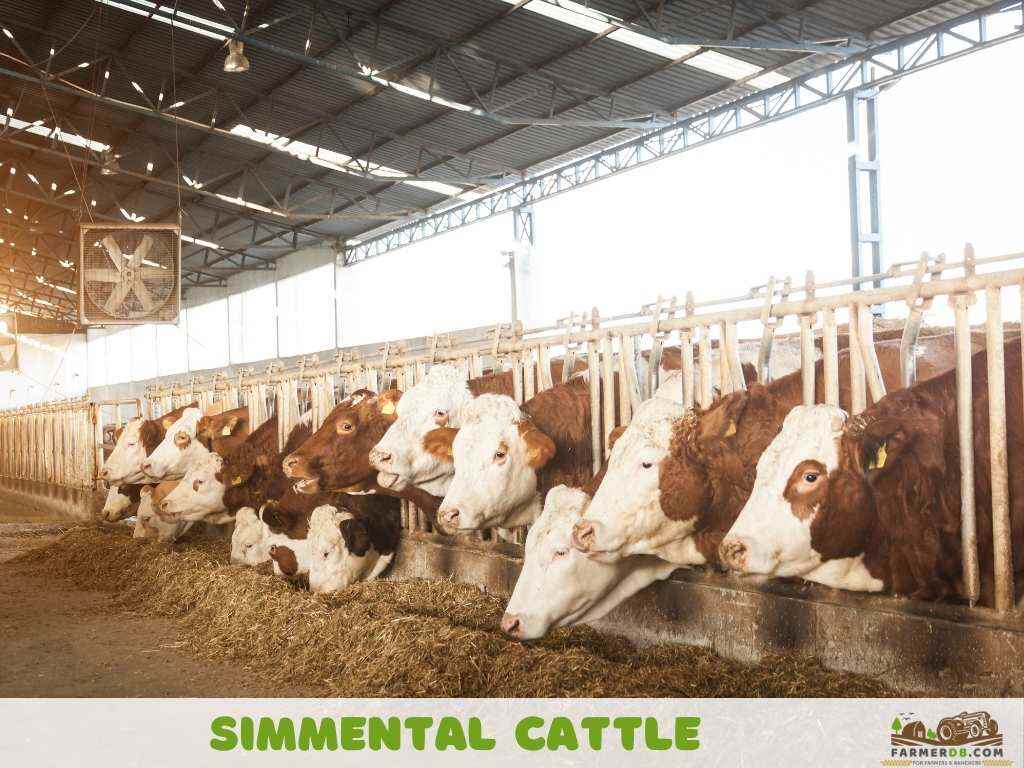
Clean, fresh water is also critical for Simmental cattle’s health and productivity. The amount of water they need depends on factors such as age, body weight, and stage of production. On average, a mature cattle may drink 25–50 gallons (95–190 liters) of water per day, with lactating cows and cattle in hot climates consuming even more.
They can thrive under either feeding regimen, thanks to their adaptability. The choice ultimately depends on your production goals: if you aim to prioritize beef production and achieve faster growth rates, incorporating grains may be the better option. Otherwise, a grass-based diet is a perfectly suitable approach.
Environment
Open pasture systems, confinement or semi-intensive setups, and mixed systems, no matter the type of environment, these cattle perform well in all of them as long as they receive proper care.
Climate
Just as they adapt well to different environments, these cattle also show versatility when it comes to climate. They can perform well and develop in a wide range of conditions, including temperate, cold, and warm climates, as well as high-altitude and arid environments.
Shelter
Even hardy breeds like Simmental benefit from having a sheltered place to escape harsh conditions such as wind, rain, intense sun, or freezing temperatures.
A protected space is also important when there are newborn calves that need to stay warm, dry, and safe from predators.
How many cattle per acre?
You can raise 1 Simmental cattle per 3 to 5 acres of high-quality pasture with dense forage. In the case of low-quality or overgrazed pasture, you may need more than 5 acres per animal.
This number can vary based on local conditions, pasture quality, diet, and management intensity.
Some of the guidelines to consider when determining acreage are the following:
- In temperate regions with consistent rainfall, pasture grows more reliably, allowing for higher stocking rates.
- In drier or colder climates, where forage production is seasonal, more land may be required to maintain cattle year-round, or additional feed may need to be provided.
- Rotational grazing can improve pasture utilization, potentially reducing the number of acres needed per animal.
- Supplementing with hay, silage, or grains can reduce grazing acreage requirements, although it increases feed costs.
- If forage is the primary source of nutrients for both lactation and growth, slightly more acreage may be necessary.
Breeding
You can begin breeding these cattle at 15 to 18 months of age.
With these cattle, you don’t need to worry about fertility as they score very high in fertility rates.
In small herds, or when bulls are available on the farm, natural mating is often used. However, artificial insemination is also quite common, especially in larger operations or when the goal is to improve genetics, increase hybrid vigor, or introduce specific desirable traits.
The timing of breeding depends largely on the region. For example, in temperate areas, many farmers aim for spring or fall calving, when pasture is most plentiful.
An interesting characteristic of this breed is that twinning is more common than in many other cattle breeds.
The gestation length is around 283 days, similar to other beef breeds. Most Simmental cows calve easily without assistance. They are well-known for their ease of calving, which often requires only a designated space and close observation, rather than hands-on intervention.
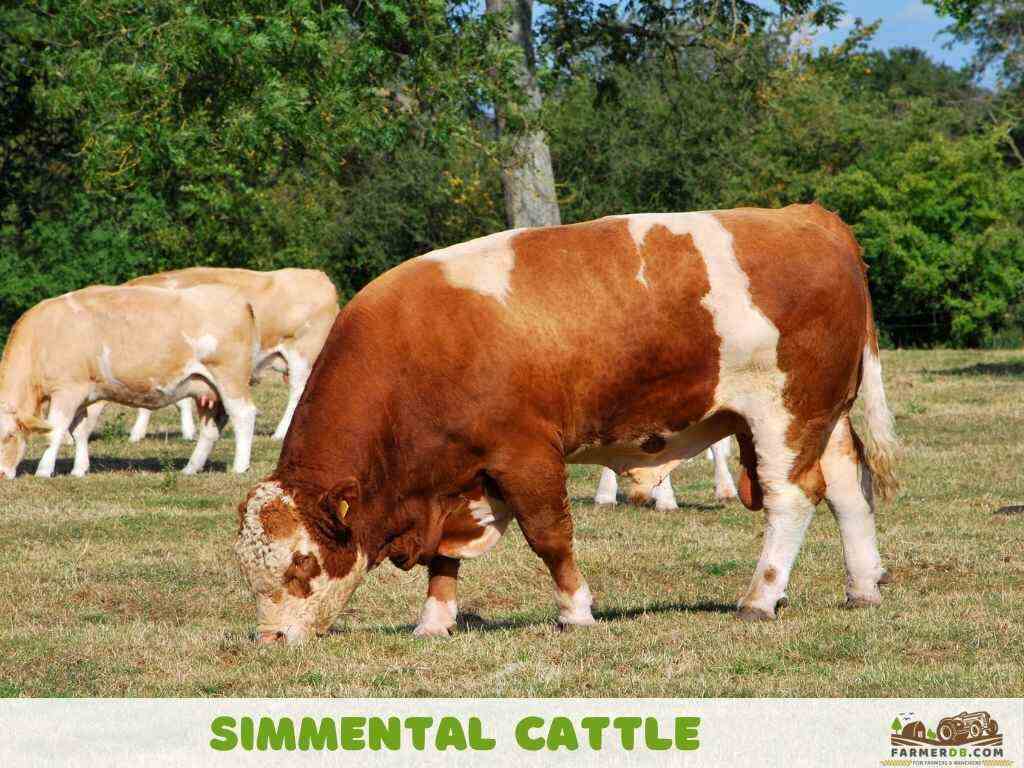
In addition, these cows have good maternal instincts and produce plenty of milk to raise their calves.
The bull of this breed is widely used in crossbreeding programs due to its ability to pass on hybrid vigor. The resulting offspring often demonstrate improved growth rates, better feed efficiency, enhanced fertility, and stronger overall health.
Some of the most popular crossbreeding models are:
- Simmental x Angus (SimAngus): A common combination that blends the maternal qualities and marbling of Angus with the growth rate, size, and muscle of Simmental.
- Simmental x Hereford: Combines the hardiness and efficiency of Hereford with the Simmental’s productivity, resulting in robust and adaptable offspring.
- Simmental x Charolais: Produces heavy calves with very good growth rates and carcass traits, appealing for beef operations focused on high yields.
- Simmental x Holstein: In dairy systems, crossing Simmental with Holstein can improve fertility, longevity, and overall durability while maintaining good milk production.
Terminal vs. Maternal
These cattle are both maternal and terminal.
They possess strong maternal traits, high milk production, and fertility. At the same time, they possess terminal traits such as efficient feed conversion, large carcasses, and high returns in meat production.
Health Issues
These cattle are a hardy and flexible breed with no major health problems that are unique to them. Most issues they face come from their environment, diet, or how they are cared for, rather than from weaknesses in the breed itself.
Some potential problems include udder health issues like mastitis, nutritional deficiencies in areas with poor soil quality, respiratory issues in poorly ventilated indoor conditions, and internal and external parasites. However, with proper care, a balanced diet, and good management, these issues can usually be managed or prevented.
Why should you raise it?
Simmental cattle offer a unique combination of traits that make them a great choice for any scale of farming from homesteads to large-scale operations.
For Homesteaders
As a homesteader, you’ll find plenty of reasons to choose Simmental cattle. They are gentle and docile, making them easy to handle even for those who may not have extensive livestock experience. Their manageable temperament means that daily chores like feeding, milking, and general care are far less stressful.
Their efficiency in converting feed into quality beef makes them a good source of home-raised protein. If your focus leans toward dairy, their milk production is impressive. A single cow can produce enough high-quality milk for household use.
With prices for weaned calves often starting between $1,500 and $2,000, the initial investment is far more affordable than that of many other breeds. Considering their lifespan, productivity, and easy maintenance, this breed provides tremendous value for the money.
Small and Large-Scale Businesses
Simmental cattle shine in small and large-scale operations, where efficiency and return on investment are key.
- Their hardy nature means fewer health issues and lower veterinary bills.
- With high daily weight gains, they reach market weight more quickly, reducing production costs.
- Good fertility and reliable calving reduce the downtime between producing new calves, ensuring a steady flow of revenue.
- You can produce high-quality registered breeding animals and sell heifers and bulls at premium prices, often ranging from $2,000 to $10,000 or more.
- The breed’s favorable dressing percentage means more marketable meat from each animal. If you’re processing 100 head, even a modest increase in yield can translate to thousands of extra pounds of beef to sell.
- The quality of Simmental beef makes it attractive for premium markets. Large-scale producers can tap into niche markets such as grass-fed or organic beef, which command premium prices per pound.
Advantages
- Dual-purpose: excellent milk and meat production.
- High fertility, strong maternal instincts.
- Fast growth.
- Gentle temperament, easy to handle.
- High dressing percentage.
- Adaptable to various climates.
- Longevity and productive lifespan.
- Hybrid vigor improves offspring.
Disadvantages
- Larger size means higher feed requirements.
- Twinning may need extra care.
- More land needed in low-quality grazing areas.
- Initial cost of registered breeding stock.
Do you have any experience with the topic discussed here?
Would you like to improve the information shared and contribute your practical knowledge on the subject?
Your real-world experience as a farmer or rancher could greatly benefit other members, and the community would deeply appreciate your contribution.
